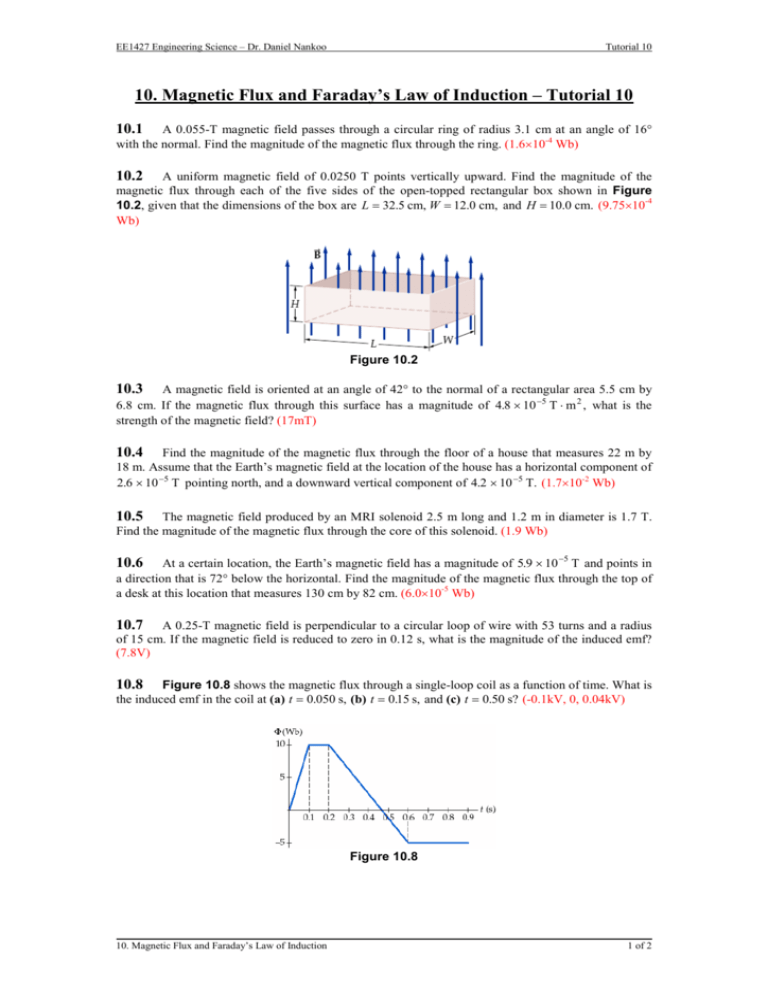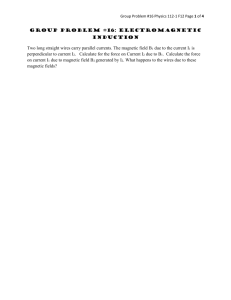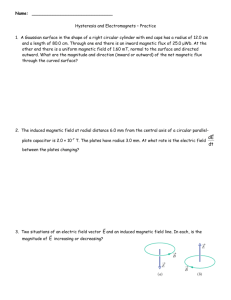10. Magnetic Flux and Faraday's Law of Induction – Tutorial 10
advertisement

EE1427 Engineering Science – Dr. Daniel Nankoo Tutorial 10 10. Magnetic Flux and Faraday’s Law of Induction – Tutorial 10 10.1 A 0.055-T magnetic field passes through a circular ring of radius 3.1 cm at an angle of 16° with the normal. Find the magnitude of the magnetic flux through the ring. (1.6×10-4 Wb) 10.2 A uniform magnetic field of 0.0250 T points vertically upward. Find the magnitude of the magnetic flux through each of the five sides of the open-topped rectangular box shown in Figure 10.2, given that the dimensions of the box are L = 32.5 cm, W = 12.0 cm, and H = 10.0 cm. (9.75×10-4 Wb) Figure 10.2 10.3 A magnetic field is oriented at an angle of 42° to the normal of a rectangular area 5.5 cm by 6.8 cm. If the magnetic flux through this surface has a magnitude of 4.8 × 10 −5 T ⋅ m 2 , what is the strength of the magnetic field? (17mT) 10.4 Find the magnitude of the magnetic flux through the floor of a house that measures 22 m by 18 m. Assume that the Earth’s magnetic field at the location of the house has a horizontal component of 2.6 × 10 −5 T pointing north, and a downward vertical component of 4.2 × 10 −5 T. (1.7×10-2 Wb) 10.5 The magnetic field produced by an MRI solenoid 2.5 m long and 1.2 m in diameter is 1.7 T. Find the magnitude of the magnetic flux through the core of this solenoid. (1.9 Wb) At a certain location, the Earth’s magnetic field has a magnitude of 5.9 × 10 −5 T and points in a direction that is 72° below the horizontal. Find the magnitude of the magnetic flux through the top of a desk at this location that measures 130 cm by 82 cm. (6.0×10-5 Wb) 10.6 10.7 A 0.25-T magnetic field is perpendicular to a circular loop of wire with 53 turns and a radius of 15 cm. If the magnetic field is reduced to zero in 0.12 s, what is the magnitude of the induced emf? (7.8V) 10.8 Figure 10.8 shows the magnetic flux through a single-loop coil as a function of time. What is the induced emf in the coil at (a) t = 0.050 s, (b) t = 0.15 s, and (c) t = 0.50 s? (-0.1kV, 0, 0.04kV) Figure 10.8 10. Magnetic Flux and Faraday’s Law of Induction 1 of 2 EE1427 Engineering Science – Dr. Daniel Nankoo Tutorial 10 10.9 The magnetic flux through a single-loop coil is given by Figure 10.8. (a) Is the magnetic flux at t = 0.25 s greater than, less than, or the same as the magnetic flux at t = 0.55 s? Explain. (b) Is the induced emf at t = 0.25 s greater than, less than, or the same as the induced emf at t = 0.55 s? Explain. (c) Calculate the induced emf at the times t = 0.25 s and t = 0.55 s. (0.04kV) 10.10 A single conducting loop of wire has an area of 7.4 × 10 −2 m 2 and a resistance of 110 Ω. Perpendicular to the plane of the loop is a magnetic field of strength 0.28 T. At what rate (in T/s) must this field change if the induced current in the loop is to be 0.32 A? (480T/s) 10.11 The area of a 120-turn coil oriented with its plane perpendicular to a 0.20-T magnetic field is 0.050 m 2 . Find the average induced emf in this coil if the magnetic field reverses its direction in 0.34 s. (7.1V) 10.12 An emf is induced in a conducting loop of wire 1.12 m long as its shape is changed from square to circular. Find the average magnitude of the induced emf if the change in shape occurs in 4.25 s and the local 0.105-T magnetic field is perpendicular to the plane of the loop. (5.3×10-4V) 10.13 A magnetic field increases from 0 to 0.20 T in 1.5 s. How many turns of wire are needed in a circular coil 12 cm in diameter to produce an induced emf of 6.0 V? (4000) 10. Magnetic Flux and Faraday’s Law of Induction 2 of 2






